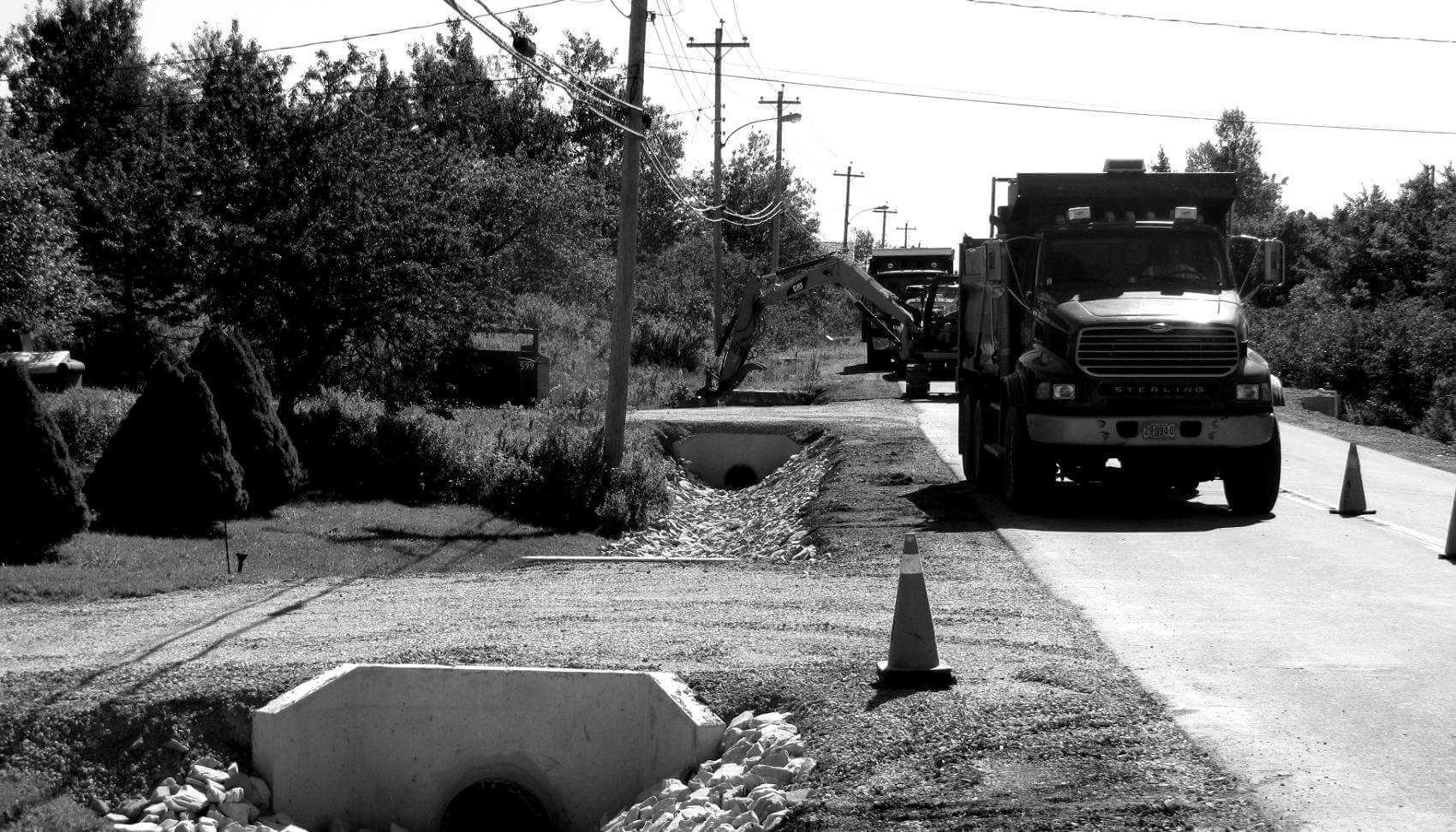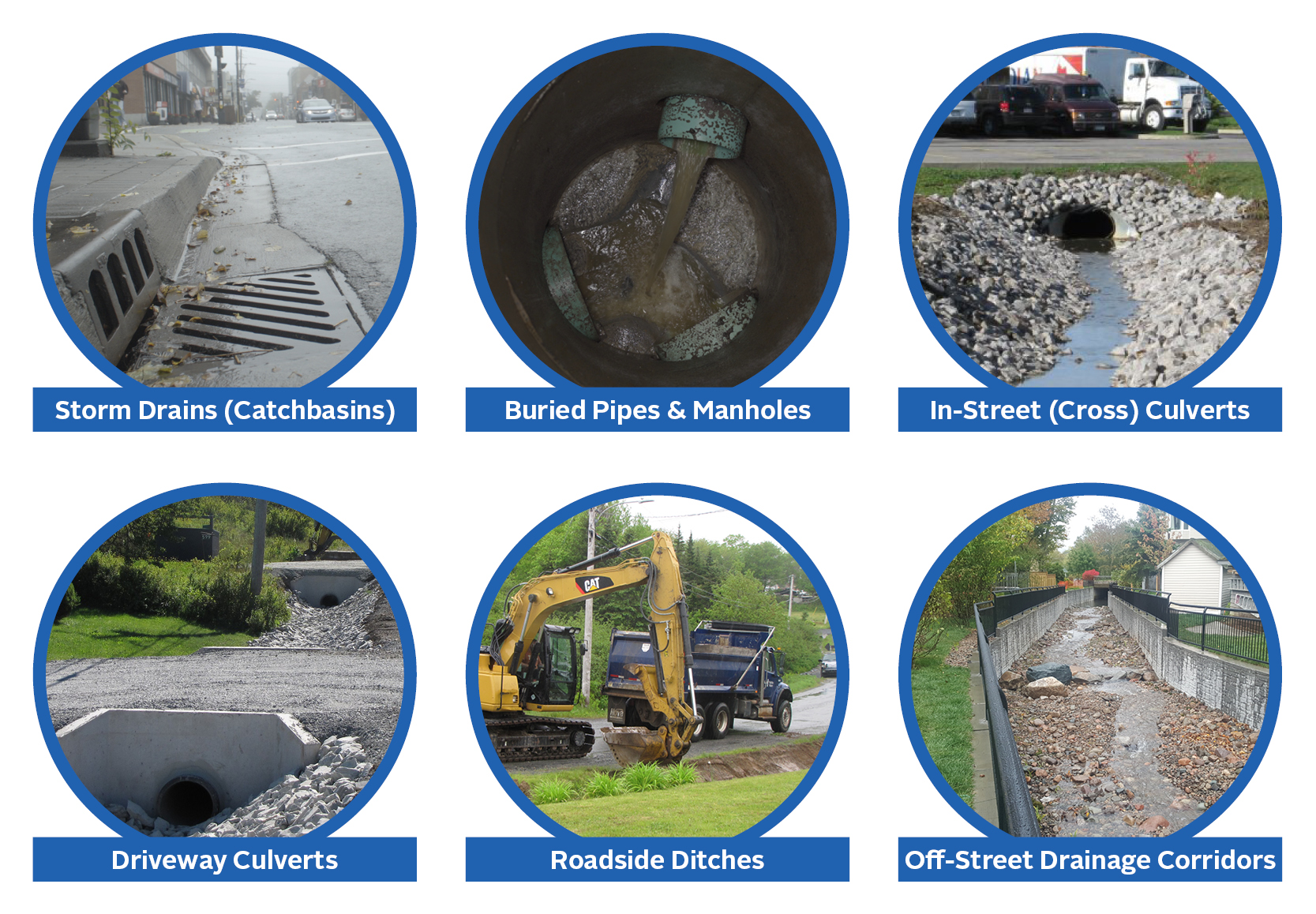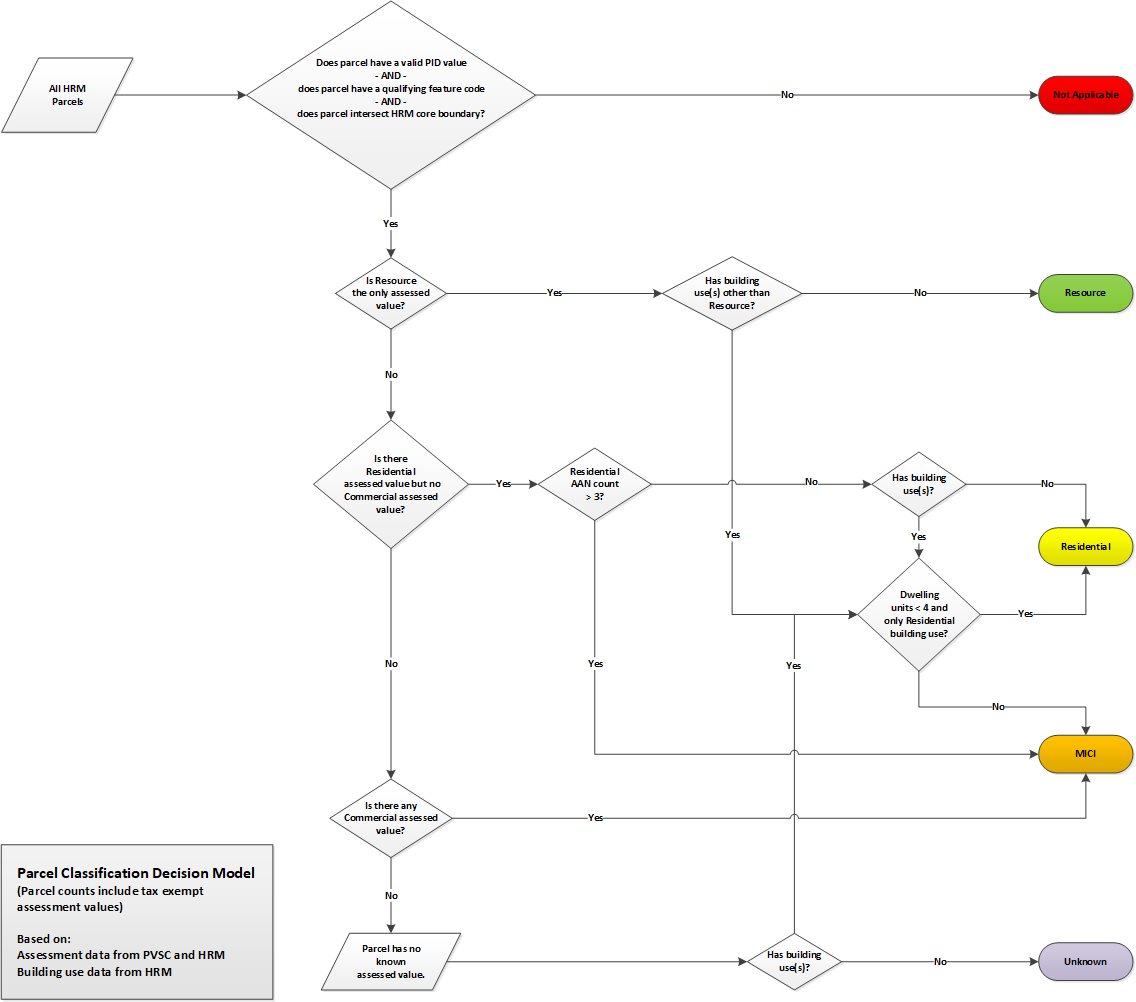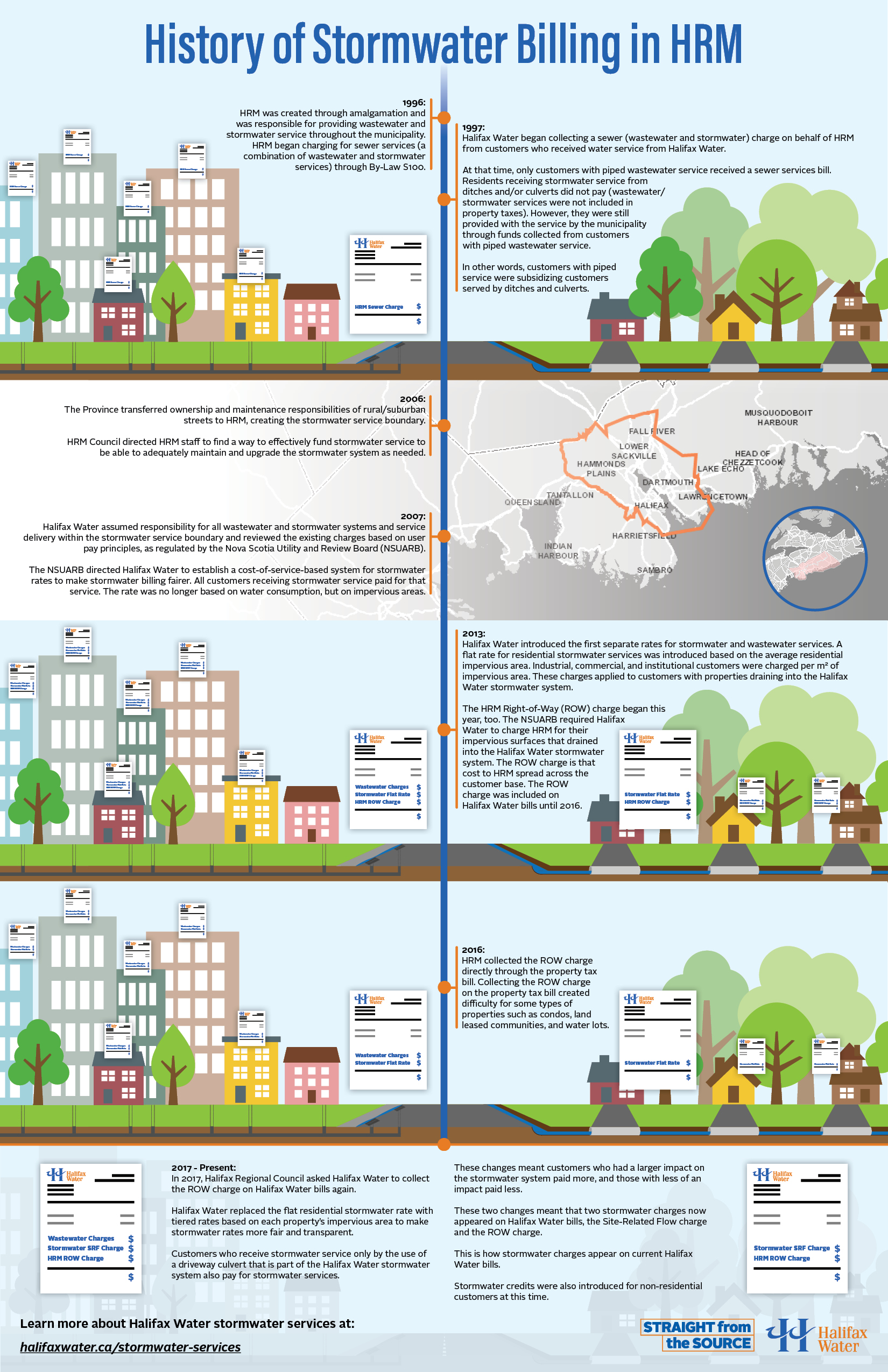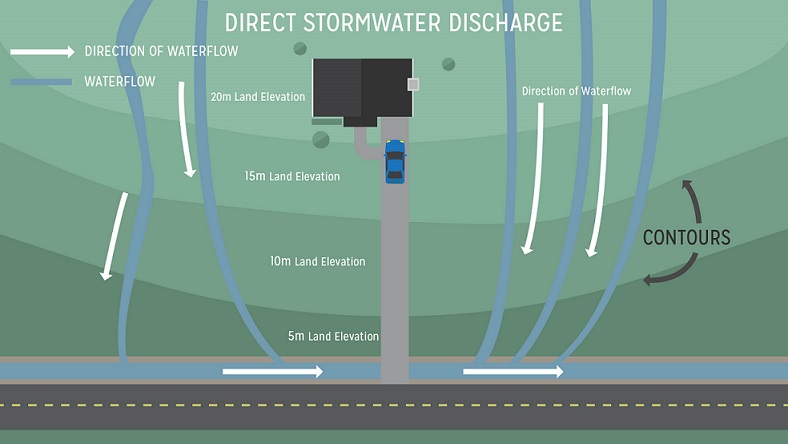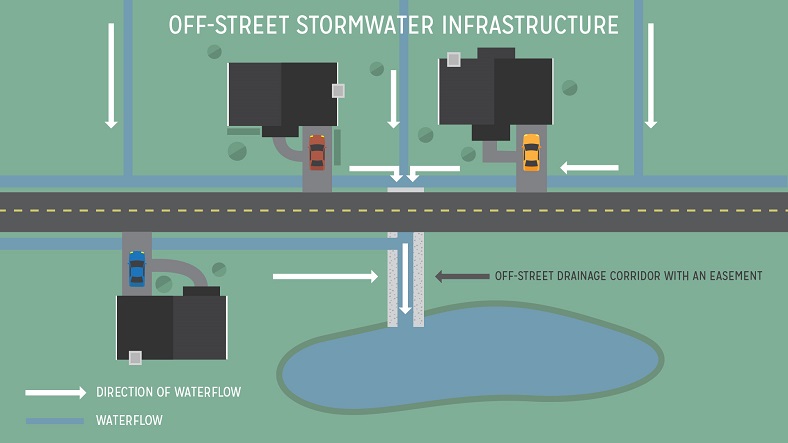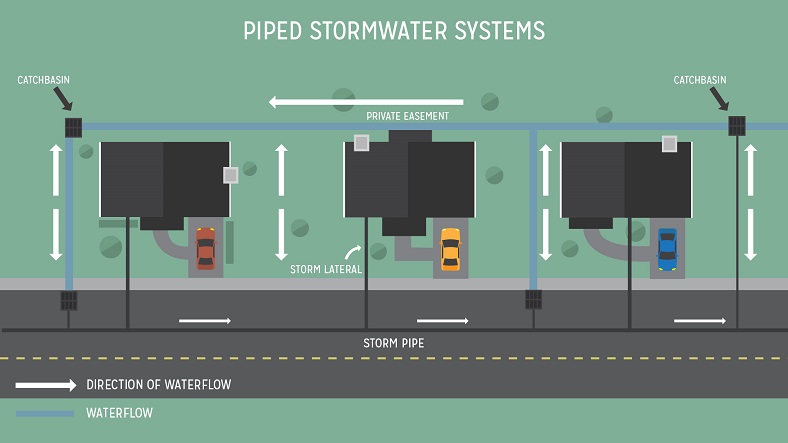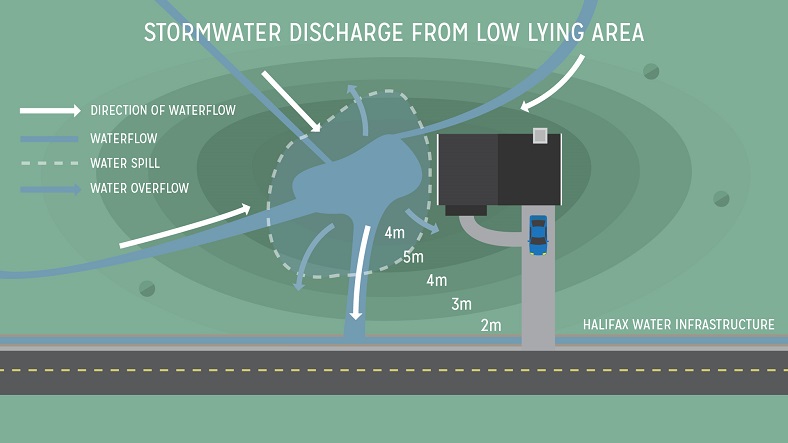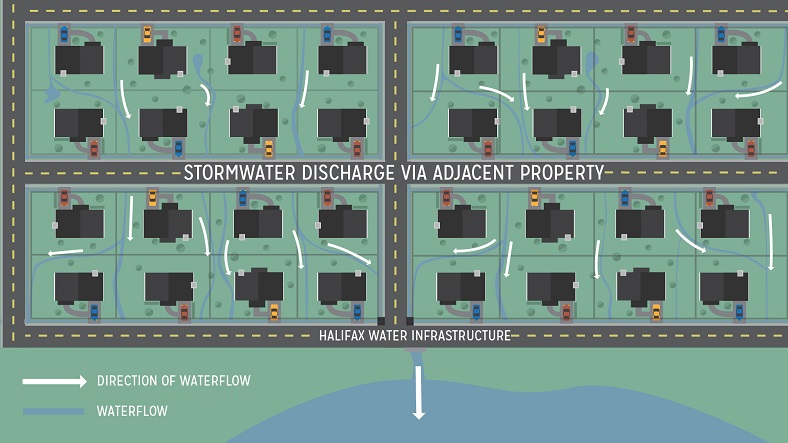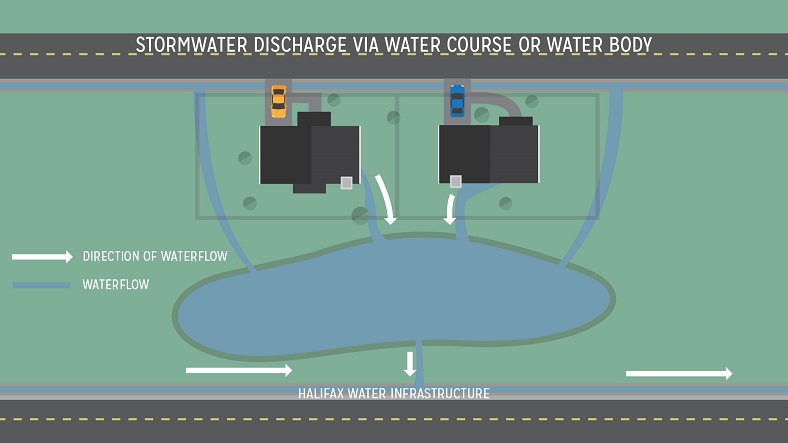Stormwater is the water from rain, melted snow and ice, that runs off roofs, parking lots, driveways, and other hard surfaces. Halifax Water provides stormwater services to thousands of customers throughout Halifax Regional Municipality.
For some, this means ditches and culverts. For others, it means storm drains in the street (catchbasins) and underground pipes.
On July 16, 2021, Halifax Regional Municipality staff submitted a proposal to Halifax Regional Council (Council) to approve a road transfer from the Province of Nova Scotia. This is in accordance with a Road Transfer Agreement (titled HRM-01) between HRM and the Province, which was signed in 1996.
On July 20, 2021, Council will vote on these road transfers. Pending Council’s approval, Halifax Water will be given responsibility for stormwater services in the expanded area set by HRM. This Halifax Water Stormwater Service Boundary matches the HRM Urban Core Boundary.
On April 13, 2022, the NSUARB approved Halifax Water's application to accept responsibility for stormwater services in these two expanded areas.
On June 1, 2022, Halifax Water became responsible for stormwater services in the two expanded areas.
How does Halifax Water manage stormwater?
In 2006, the Province of Nova Scotia transferred ownership and maintenance responsibilities of streets within the Urban Service Boundary to HRM. HRM Council directed HRM staff to find a way to properly fund stormwater service to be able to maintain and upgrade the stormwater system properly.
In 2007, Halifax Water assumed responsibility for wastewater and stormwater service delivery within the Urban Service Boundary. The Halifax Water Stormwater Boundary covers the same area as the Urban Service Boundary.
You can view the Stormwater Boundary map in a new browser window.
Questions about Stormwater Services
Halifax Water is responsible for the efficient flow of stormwater through the stormwater system. This includes:
- ditches
- culverts
- catchbasins
- retention ponds, and;
- other public stormwater assets.
Halifax Water is not responsible for the cosmetic grooming of ditches. The utility will clear blockages of soil and vegetation in a ditch or culvert if it stops the flow of water.
Halifax Water is not responsible for clearing debris or blockages at the street level, above stormwater system catchbasins/storm drains. The utility will clear blockages that are inside of a pipe, catchbasin or storm drain if it stops the flow of water.
Directing water to the stormwater system is the responsibility of the municipality. Blockages at the street level, including on top of storm drains, are part of municipal street cleaning and are not part of Halifax Water stormwater services.
The Halifax Regional Municipality is responsible for travel surfaces on roadways, roadway shoulders, and curb and gutters, including snow removal from ditches and damages incurred during snow removal. If a property owner has damage to their headwall or culvert incurred during snow-clearing activities, this is a municipal responsibility. Also, although Halifax Water is responsible for catchbasins, the municipality is responsible for clearing snow, ice and debris from the surface of catchbasins, as part of their street snow-clearing responsibilities.
In 2006, the Province of Nova Scotia transferred ownership and maintenance responsibilities of streets within the Urban Service Boundary to HRM. HRM Council directed HRM staff to find a way to properly fund stormwater service to be able to maintain and upgrade the stormwater system properly.
In 2007, Halifax Water assumed responsibility for wastewater and stormwater service delivery within the Urban Service Boundary. The Halifax Water stormwater boundary covers the same area as the Urban Service Boundary.
Halifax Water was a water utility from 1945 until 2007 when HRM transferred wastewater and stormwater responsibilities to Halifax Water.
This change meant Halifax Water became a One Water utility offering three core services: water service, wastewater service, and stormwater service. Some customers receive all three services; some receive two, and some only one service.
While water service and wastewater service are often linked (customers receiving water service from Halifax Water are often also wastewater customers), stormwater services have nothing to do with whether or not a property receives water and/or wastewater services from Halifax Water.
Halifax Water provides stormwater service to all properties within the stormwater boundary that contribute stormwater to the Halifax Water stormwater system or have a driveway culvert that Halifax Water is responsible for maintaining or replacing.
Find out more about Halifax Water stormwater charges further down this page, or by clicking here.
I have a ditch that runs along my property. How does Halifax Water provide stormwater service to me?
As simple as they may seem, roadside ditches are a vital part of the stormwater system in HRM. Halifax Water owns and maintains over 600 KM of ditches in our service area.
Ditches are used to direct stormwater toward a nearby body of water, like a stream, a river, a lake, or the ocean.
If the ditch near your property becomes blocked and water can't go where it needs to, give us a call, and we'll send someone out to take a look and then, if needed, schedule a crew to repair it.
Repairing or maintaining a ditch generally involves an excavator, a dump truck or two, and a crew. Once everything is on-site, the crew gets to work fixing the ditch. This cost is covered as part of your stormwater service.
Note: Halifax Water is not responsible for the cosmetic grooming of ditches. The utility will clear blockages of soil and vegetation in a ditch or culvert if it stops the flow of water.
To see example images of how some properties receive stormwater service, click here or scroll down to the "Understanding Stormwater Flow from your Property" section of this page.
Halifax Water owns and maintains about 16,000 driveway culverts in HRM.
Ditches and driveway culverts go hand-in-hand. Water flowing through the ditch needs to go by your driveway to get to its destination, usually a nearby body of water, like a stream, a river, a lake, or the ocean. Rather than letting the water fill the ditch and wash over your driveway, which can lead to washouts (erosion), a driveway culvert is installed to let stormwater pass underneath your driveway.
Halifax Water comes in when/if your driveway culvert needs to be repaired or replaced. If the culvert is no longer letting stormwater through, or if the driveway culvert is collapsing, give us a call, and we'll send someone out to take a look and, if needed, schedule a crew to repair or replace it.
Repairing or maintaining a culvert generally involves an excavator, a dump truck or two, and a crew. Once everything is on-site, the crew gets to work fixing the culvert. This cost is covered as part of your stormwater service.
To see example images of how some properties receive stormwater service, click here or scroll down to the "Understanding Stormwater Flow from your Property" section of this page.
On most HRM streets with curbs or sidewalks, stormwater is collected with storm drains (catchbasins) in the street. These are like a big version of the drain in your shower or sink. Water flows to low points in the street and drains into the catchbasin. From there, it flows through underground pipes to its destination.
It's up to Halifax Water to make sure these catchbasins are working, and with nearly 25,000 catchbasins throughout our service area, it's a full-time job. If a catchbasin is damaged, give us a call, and we'll send a crew out to fix or replace it.
There is something of a shared responsibility between HRM and Halifax Water when it comes to clogged catchbasins:
- If a catchbasin is blocked by leaves, snow, or other debris on the street, HRM is responsible for clearing off the catchbasin. This is part of their street cleaning and snow clearing work.
- If the catchbasin is clogged inside with anything at all, then Halifax Water staff are responsible for clearing out the blockage. Just give us a call, and we’ll send a crew out as soon as we can.
- During severe weather events, like hurricanes and snowstorms, Halifax Water staff work with HRM to prevent localized flooding by clearing leaves or snow off of catchbasins.
To see example images of how some properties receive stormwater service, click here or scroll down to the "Understanding Stormwater Flow from your Property" section of this page.
Yes, we will. That's part of what the stormwater rates pay for. When a property is developed, if a driveway culvert is needed, it is the responsibility of the developer/builder to install a driveway culvert to access the property. Once the developer has installed the driveway culvert and it's been approved by a Halifax Water inspector, future repairs and replacements are our responsibility.
If your culvert is collapsing or no longer letting stormwater through, give us a call, and we'll send someone out to take a look and, if needed, schedule a crew to repair or replace it.
Driveway culverts can be made out of many materials and can look different from property to property. When a property is developed, it is the responsibility of the developer/builder to install a driveway culvert to the building code in place at that time. Depending on when the property was developed and what materials the developer used, your driveway culvert may be different from others on your street.
Whatever your driveway culvert looks like, if you're a Halifax Water stormwater customer, you're covered if it needs to be repaired or replaced. Just give us a call, and we'll take a look.
Service is delivered to ensure systems are operating in all areas. For areas not on the piped system, there is a significant cost because Halifax Water does ditch cleaning and culvert replacements.
Halifax Water spends millions of dollars every year operating and maintaining the stormwater system and investments in the system.
In 2021/22, Halifax Water has a capital budget of $12.8 million dollars for stormwater service.
Halifax Water uses Property Valuation Services Corporation’s (PVSC) assessment data to determine if a property should be billed as residential or non-residential. PVSC identifies every property using an assessment number (AAN). PVSC regularly reviews property use and assesses which category properties fit into, such as residential, commercial, resource or a combination of commercial and residential and/or resource (mixed use). More information regarding PVSC can be found by accessing the following link: About PVSC .
In addition, Halifax Water also uses Halifax Regional Municipality’s (HRM) building use data, which provides the number of dwelling units on a property and what those dwelling units are being used for.
A property is identified as residential for stormwater billing purposes if it meets any of the following criteria:
- Any property that has been assessed by PVSC as residential only and has three or less dwelling units.
- Any property that has been assessed by PVSC with a combination of residential and resource and has three or less dwelling units.
Multi-Residential, Institutional, Commercial, and Industrial (MICI) properties are included within non-residential properties. A property is identified as non-residential for stormwater billing purposes if it meets any of the following criteria:
- Any property that has any commercial assessed value.
- Any property considered as mixed use (having commercial assessment along with residential and/or resource assessment).
- Any property having more than three dwelling units.
- Any property having more than three residential assessments associated with it.
- Any property having a commercial building use.
The following flowchart outlines the process used by Halifax Water to classify a property as residential or non-residential:
Any property identified by Halifax Water as unknown or resource is not billed for stormwater services.
Yes. Many cities use impervious area as the basis for stormwater charges. Halifax Water is leading the industry in standards with respect to methods to provide precision in terms of measurement of impervious areas for billing purposes.
The Site-Related Flow (SRF) charge is a Halifax Water charge. It is based on the amount of impervious/hard surfaces (i.e.: roofs, asphalt, concrete, and packed gravel) on private property. Those surfaces don’t absorb stormwater. Instead, it flows into Halifax Water's stormwater system. The SRF charge is a tiered system, the more hard surface a property has, the higher the tier and cost.
The HRM Right of Way (ROW) charge is a Halifax Regional Municipality charge for the management of stormwater that comes from the public street right of way into Halifax Water's stormwater system. Essentially, HRM is a customer with a large impervious area (streets/roads). Halifax Council made a decision to collect this charge through Halifax Water's billing. All customers that are billed stormwater service pay for the ROW charge. Effective April 1, 2023, per a decision by Halifax Regional Council, the HRM ROW charge will be moving from Halifax Water bills to the municipal tax bill. Learn more here.
This was one of the options considered by Regional Council. Initially, it was preferred to have this charge collected by Halifax Water. In 2016, the municipality collected the HRM Right-of-Way charge directly through the property tax bill. Collecting the charge on the property tax bill created difficulty for some types of properties such as condos, land leased communities, and water lots. As a result, for 2017 and subsequent years, Regional Council has opted to have Halifax Water collect the charge on our stormwater bills.
Effective April 1, 2023, per a decision by Halifax Regional Council, the HRM ROW charge will be moving from Halifax Water bills to the municipal tax bill. Learn more here.
Halifax Water engineering staff use topographic maps and satellite imagery to create watershed boundaries and maps showing the location of Halifax Water-owned stormwater infrastructure to determine which properties within the stormwater boundary receive stormwater service from Halifax Water. We are continuing to update and improve our data.
Mid-year physical state changes would be assessed by staff based on information provided by the customer, with site visits as required.
Understanding Stormwater Flow from your Property
Halifax Water stormwater infrastructure may be directly adjacent to your property, or it may be some distance away, in which case stormwater may have to flow overland, along roadways, or through watercourses (lakes, rivers, etc.) before reaching the Halifax Water stormwater system. Most of the properties within the boundary receive one or more of the following services from Halifax Water:
- Stormwater from the property enters any part of Halifax Water's stormwater system
- The property is accessed directly by a driveway that crosses over a Halifax Water culvert
Use the images in the labelled boxes below to help you determine how stormwater flows from your property:
Stormwater Billing Exemptions
Halifax Water has “exempted” any properties that do not contribute stormwater into the public system and do not have a driveway culvert. For example, a property the drains down-hill into a lake that does not drain into Halifax Water-owned infrastructure and does not have a driveway culvert.
Stormwater Billing Appeals
You can appeal your Halifax Water stormwater bill if you feel you do not receive stormwater service from Halifax Water, or that you have otherwise been improperly billed.
The “appeal” process is provided for in Section 7 of the Halifax Water Regulations. The language used in the Regulations is “Notice of Objection”.
You must file a Notice of Objection with Halifax Water outlining why you believe no stormwater is discharged from your property into the Halifax Water stormwater system. You can follow the same procedure as the Formal Complaints procedure.
What if I Don't Like the Answer I Received from Halifax Water?
If you wish to appeal Halifax Water’s written reply to your Notice of Objection , a complaint may be made to the Dispute Resolution Officer (DRO).
The Dispute Resolution Officer is an independent officer (not an employee of Halifax Water or the Nova Scotia Utility and Review Board) who manages regulation based on customer issues.
